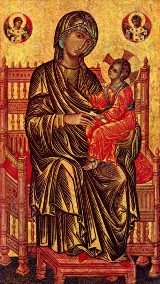
It is not challenging. I will explain this later, but in the meantime I would be grateful if you bear with me on an excursion through the last millennium or so of art. My aim is to understand the underlying values which inform current art language and to provide some helpful imperatives on how to approach this with a consistent rationale for the future.
My conclusions have come about from a wider perspective than merely last week’s sensationalised art news stories or even the last decade’s, so to do justice to myself and to you, dear reader, I will review that perspective. You may agree, disagree or litter the destination with caveats, but I hope the journey will be enjoyable, if not stimulating, and at least provide an understanding as to how I have arrived at my present position.
For this purpose, the Middle Ages are a fine dialectical place to begin, being the thesis with the Renaissance as the antithesis and the last century or so of Modernism – including its current spawning – as the earnest striving (at least prior to its current spawning) for synthesis, which has to date proved as elusive as it is alluring.
The Medieval period was nothing if not theological with a biblical fixation and fervour shaping all areas of life, including art, albeit that this activity was then the province of journeymen rather than celebrities. The material world was one of sin and the only world of any worth was God’s heavenly one, polarised with Satan’s somewhat less heavenly alternative for the somewhat less deserving.
As the heavenly world was not the material one around us, observation of the latter would be of little use in depicting it. A degree of abstraction was appropriate for an abstract dimension – not the complete geometrical abstraction of Islamic art with a similar goal, but at least abstraction to a degree that flattened forms, defined shapes with hard contours, depicted folds of cloth as stylised patterns, and minimised depth (please remember those characteristics, as they will reappear many centuries and a few paragraphs later),
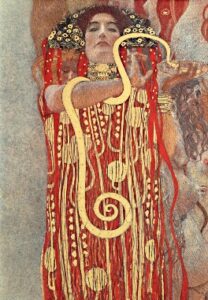
In 1979, I had the distinction of being the only student in 10 years to fail the painting degree at Maidstone College of Art, which was being remorselessly hijacked by aesthetic technocrats, a seemingly endless supply of whom were emerging from a production line at the Royal College of Art. One of the dying breed of artistic savants still surviving this invasion was a tutor in his sixties called Paul Harris. He had previously been a monk and also a soldier evacuated in 1940 from Dunkirk. He decided not to fire at a German plane on the basis that he would probably miss anyway, but would still have to clean his rifle afterwards.
One thing he bothered about, apart from his painting and the ladies, was knowledge in general and history in particular. Various of his epigrams have stayed with me over the years, including the way he contrasted the Medieval and Renaissance periods by the example of how each would go about establishing the number of teeth in a horse’s mouth, the former by looking in scripture to find the answer and the latter by looking in a horse’s mouth.
The origin of this comparison is, I have subsequently found out, subject to some mystery and may be satirical, but is still nevertheless illuminating. Thomas Aquinas (1225-74) only apocryphally mentioned angels dancing on a pin, but he did actually discuss whether several angels could be in the same place at the same time, an enquiry scorned by the Renaissance but deserving of a rectified reverence in own times – something else I will return to later.
Medieval art was, to put it crudely, all the same: over 1000 years of adoration and piety with saints, saints and more saints, not to mention identikit Madonnas with child, gruesome crucifixions and angelic confabulations, Christ’s poverty being communicated to the masses by profusions of gold leaf enhanced with the rich blue pigment of powdered semi-precious lapis lazuli stone. Sorry, that wasn’t poverty, of course – it was the splendour of heaven. Easy to confuse these things.
In contrast to this, the Renaissance was a marvellous liberation from the Byzantine-biblical-aesthetic straightjacket of flatness and pattern. It was launched by what now seems a tame departure but at the time was as stunning in its potential as the launch of internet was to us today. All the shops were shut and a fourteen-foot wide panel painting, The Rucellai Madonna, commissioned in 1285 from the artist Duccio di Buoninsegna, was carried in a solemn celebratory procession from his studio to the Florentine church of Santa Maria Novella.
From this point on, the Renaissance got in its stride like a 100 metre sprinter when the gun is fired. You can literally walk through the subsequent rapid evolution of art by visiting London’s National Gallery and doing a chronological tour starting at the earliest work of around 1250. The experience is like watching a pop-up book being unfolded, as the relentless development of three-dimensional rendering takes place over the following two-and-a-half centuries, until the mastery of it is demonstrated around 1500 with the High Renaissance triumvirate of Leonardo, Michelangelo and Raphael..
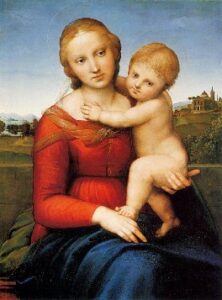
The next 500 years then became as rigid in their imposition of artistic techniques as the previous 1000 years had been, and maintained an orthodoxy every bit as rigid and (ultimately) as stultifying as the orthodoxy it replaced. Every artist, again, did the same thing – not this time the flatness of the ethereal world, but the complete opposite, circumscribed by the distant horizon of the material world.
Gold leaf fell distinctly out of favour, as did patterned emphasis on the picture surface, hard edges, flat drapery, brilliant colouration and the attendant iconography of halos, until the heavenly landscape was replaced by the landscape of Flatford Mill and the limp body of the dead Christ by the limp body of a dead pheasant in a still life, while the power and patronage previously bestowed by the Holy Church descended through royalty and nobility to burghers and finally owners of satanic mills in Lancashire.
There were several major and unquestionable requirements of the new artistic faith. The core unshakeable philosophy was the necessity of rendering an illusion of the external world as perceived by the eye. The scenic backdrop was created by a universally endorsed mono-point linear perspective, commonly demonstrated in more recent text books by a receding railway track which gets narrower the further away it is meant to be, fooling the brain into a sense of horizontal distance behind the physical surface of the picture, rather than pointing out what is really there, namely a vertical triangle.
This is allied with aerial perspective, which comes about through the cumulative effect of atmospheric moisture, effectively acting in the same way as a series of veils to progressively diminish the intensity of colour, tonal extremities and detailed definition of objects the further away they are, so that in the distance everything becomes a hazy mid-grey (or pale blue, according to taste). Objects in close-up do not necessarily fare much better, because in order to render naturalism the relatively dulling effect of daylight must be rendered by de-saturating colour (in common parlance, making it less brilliant). To depict realistic-looking foliage, the first thing you need to do with a standard green colour squeezed out of the tube is to mix into it lashings of the complementary (i.e. opposite) colour – red – so that it hastens towards grey.
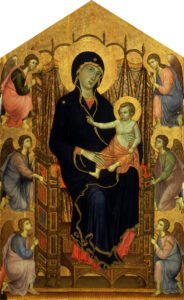
This use of colour is allied with modelling of form and texture, where the perspectival and colour systems already described are further refined to accommodate the change of light observed with the curves, recesses, highlights and shadows of solid objects. The order of the day – still being drilled into emergent artistic minds through at least most of the twentieth century – was, to quote today’s estate agents, location, location, location, or in other words observation, observation and observation.
It is worth remarking here that this obsessive observation was focused exclusively on what the eye could see, rather than what the mind might think or the heart might feel. It is of course far easier to do the former than the latter activities, particularly if you don’t think that much or feel too deeply, or at least if you don’t care to reveal too much of such matters. Artists, who wished to do so, were limited in the extent to which they could by the technical structures which they had to employ.
There was no significant deviation possible from these aesthetic strictures, and it is surely symbolic that the Renaissance system of linear perspective is the viewpoint of someone whose head is fixed in a clamp and who stares rigidly at a fixed spot in the distance. Within its fixed parameters, there is variation and development, often indeed genius, but the over-riding consideration for my present purposes is the fixed nature of these parameters, seen for a long time most notably in the sweet vision of Raffaello Sanzio da Urbino known as Raphael (died 1520).
Hence the outrage when, 328 years after his death, a group of daring and fervent painterly upstarts transgressed with the coded initials “PRB” on their canvases, standing, it was quickly revealed, for “Pre-Raphaelite Brotherhood.” Their bark was worse than their bite and though they valued the transcendent clarity of art before Raphael’s influence was corrupted (as they put it) by Mannerism, their endeavours remained funnelled down the rigid lines of the Renaissance. There is a minor exception with some of Rossetti’s early work which may be visionary or just “bad” drawing.
The crack in the dam came with Post-Impressionism and quickly turned into a torrent. The Impressionists themselves certainly provided a strong hint, but were too well schooled in Renaissance skill to make the break with it. It was left to the ham-fisted triumvirate of Vincent and the two Pauls to manifest what has become a hallmark of subsequent art, namely to invent their own personal rules – although it should be stated emphatically that these are not whimsy or arbitrary, but necessary structures to embody the response to life it was their drive to communicate.
Before pursuing this further, let us reiterate the Renaissance legacy. In a nutshell, the Medieval was spiritual and the Renaissance was material, culminating in scientific materialism – if you can’t measure it, it isn’t there or at least it isn’t important; compared with the Medieval legacy – if you can measure it, is isn’t there or at least it isn’t important. The logical conclusion of the Renaissance was the Victorian era, in particular the solid faith of the industrial revolution (and for many the British Empire) reaching its culmination and nemesis in the First World War. It was not the war itself that brought about the change, but it was certainly the most apparent and vehement manifestation at the time.
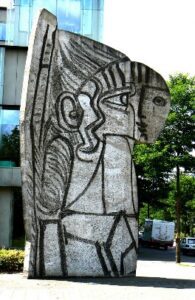
Rather more instrumental and far-reaching in terms of change was a different understanding of reality, brought about by Einstein’s relativity in perception of the outer world and Freud’s psychology in perception of the inner world. These developments posited a vision of the unseen, which, though an unintended by-product, effectively made a lot more sense of the hitherto-derided Medieval world view, which also posited a vision of the unseen, albeit using different language to do so.
Aquinas’s previously mentioned dilemma of whether more than one angel could exist in the same place was updated by quantum physics’ notion that something could be two things at the same time, existing simultaneously as a particle and a wave. Freud’s psychology was bad enough in revealing unacceptable subterranean compulsions behind daily facades, but its development through Jung succeeded in cunningly relabelling many medieval notions with apparently-scientific respectability. The four medieval humours, or temperamental types, of earth, air, fire and water reappeared in smart new suits as the cognitive functions of sensation, thinking, intuition and feeling.
In 2012, I took part in a debate at the Oxford Union about conceptual art. The broadcaster Matthew Collings was on the other team and subsequently said in his blog on the Saatchi Gallery website not only that I was like Hitler (I like to think this means I upstaged Collings) but that I also used words I didn’t understand. I wondered why he thought I didn’t understand them, as nobody else has ever levelled that accusation, and began to suspect that perhaps he didn’t understand them himself.
I suspect one word that Collings might have been musing about was “paradigm”, a particularly useful word for my present purposes, but first I had best come clean about exactly how I don’t understand what a paradigm is. It is, in my misunderstanding, a mutually agreed, or at least understood and acted on, model or structure of inter-relating concepts, values, thoughts, procedures and protocols (and no, I didn’t look all that up in Wikipedia) or, more colloquially: “this is how we think and this is how we do things round here”. A paradigm shift, then, is when such a matrix or viewpoint is replaced by another. To be a paradigm, you have to have some degree of substance. To switch preference from tuna to cheddar sandwiches would not be viewed by most informed people as a paradigm shift. To move from the Medieval period to the Renaissance would be.
Likewise, there is a paradigm shift with the transition from the Renaissance to Modernism, whose frenetic beginnings we can place, for the sake of a memorable round number, around 1900. Modernism partakes of both a continuation of the Renaissance exploration of the material world and a revival of the Medieval access to the inner world. With the renewed interest in the spiritual, aka the psychological, there was a need, as expressed by Van Gogh “for us to lift up our eyes at times, as if to see the invisible.” This reiteration of medieval focus was paralleled by an equivalent revival of medieval aesthetic, although not universally recognised as such, because it was primarily conveyed through the vogue for Japonisme and imported woodblock prints by the likes of Hokusai and Hiroshige.
Depth was no longer a necessity; patterning on the picture surface was emphasised and shapes could be defined with hard contours; the modelling revealed by light was replaced by local or invented colour; folds of cloth could be stylised patterns (marvellously demonstrated by Klimt); anatomical proportion became disposable and a matter of choice – eyes, ears and noses could be wherever Picasso wanted them to be, not where they “ought” to be. As promised a few paragraphs earlier, many of the characteristics of medieval art were reborn. Modern art is to that extent a partial renaissance of the Medieval.
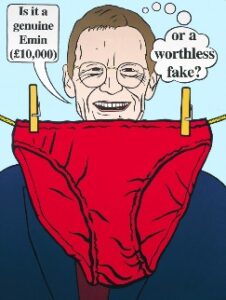
Modernism has to reject the rigidities – even if it can be awed by the achievements – of Renaissancism. The beginnings of Modernism throughout the twentieth century were a knee-jerk rejection of the swan song of the Renaissance in the nineteenth century. Rather unsubtly, Victorian values were simply swapped with their mirror image opposite. Sentiment gave way to cynicism; belief to nihilism; tradition to novelty; craft to carelessness; skill to improvisation; narrative to meaninglessness; communication to obscurantism; history to immediacy; continuation to exploration; veneration to condemnation.
This characterised the infantile beginning of a new era, but it is unfortunately a mentality which the current worldwide art establishment has not yet managed to progress beyond. A quick look at the language used shows this immediately, and a leading figure such as Sir Nicholas Serota, director of Tate (where they embarrassingly refuse to use the definite article in the gallery’s name) is a fine example of the retrograde with his artistic fundamentalism of “new media” and work which always has to be “challenging”.
I began this text by promising to say what is not challenging. The answer is that “challenging” is not challenging. It was challenging in 1917 or even in 1967 and just about in 1977. This was during the time when baby Modernism still needed to make exciting (another word past its sell-by date) new (ditto) discoveries and frequently throw toys out of the pram. The twentieth century was a time of “progress” (or so it was thought) where “new” was automatically equated to “desirable” and “beneficial”.
In farming it was automatic to thank science for insecticides that would enable carrots to fend off ravaging weeds and insects. The “progress” of more powerful insecticides enabled even more fending off. Unfortunately, delight in their efficaciousness in this respect was somewhat undermined by the fact that many pesticides are neurotoxicants, which can seep into the water table and end up coming out of the kitchen tap, a situation about which, according to the United States Geological Survey, “we don’t have sufficient scientific data to draw reliable conclusions”.
Enlightened public opinion considers it has quite sufficient data, scientific or otherwise, to draw conclusions about neurotoxicants and to prefer organic vegetables. These are the things of course which, in the distant past, always used to be known simply as vegetables. To truly play a useful contemporary role, art too has to contribute to the global phenomenon of holism and conservation, the former being an integrated view of all aspects of a situation (in contrast to the twentieth century’s specialisation), while the latter partly invokes the past in order to halt the wanton destruction which would otherwise be caused by the blind lurching juggernaut of reactionary progress.
Language embodies and reinforces values, which can be a help or an impediment to understanding. The wrong language leads to the wrong understanding and consequently to the wrong actions. The word “challenging” is a good example of a word which has been imbued so extensively with importance and force that it automatically engenders a favourable response, which it no longer merits. “Challenging” evokes sentiments of all that is best in a democracy with freedom of speech; it suggests the resistance against tyranny; it is confident that it is the finder and upholder of truth. It was once, but today we don’t need challenge. What we need is affirmation.
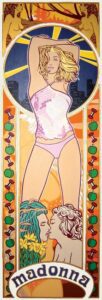
Today it is easy to knock something down. We have had a century of practice in knocking down the conventions of the past. That job has been done repeatedly to the extent that it has now in turn become a mindless convention. Today it requires considerably more ability, not to mention courage, to build something up. The task that now presents itself is one of construction by discerning and affirming values that will lead to insight and advantageous action – starting with the understanding and belief that this is not just desirable but eminently possible.
To have any worth, art, like agriculture, needs to be part of the worldwide movement to discern and rediscover what has been profligately junked from the past and to integrate it with what is of value in the present (which is of course exactly what the Renaissance did with its re-evaluation of Greek culture). In order to do this, there needs to be a re-evaluation of language and that can only come about by an understanding of the history which informs it.
As a parting thought, I might mention that in language it is not the blatantly absurd theoretical pseudo-scientific gobbledygook terminology which is pernicious: it is easy to ridicule such pretentions as “recontextualise” and “appropriate” (I appropriated some recontextualised banknotes, m’lord). The real enemy is the terminology which we accept unthinkingly and this applies of course to the wider social context, not just the artistic. I have already given examples, but will return to one of my favourites, namely the epithet “new”, not to mention its vamped up version “new improved”, as if these two conditions are intrinsic to each other and something to boast about. Whenever I see the words, I always wonder why they hadn’t made something good enough to last in the first place, and, as they hadn’t, exactly why we should believe them now.
Charles Thomson
Charles Thomson is an artist, writer, and co-founder of “The Stuckists.” The Stuckists movement is now international with active chapters in Europe and beyond
Volume 31 number 2, November / December 2016 pp 7-13
